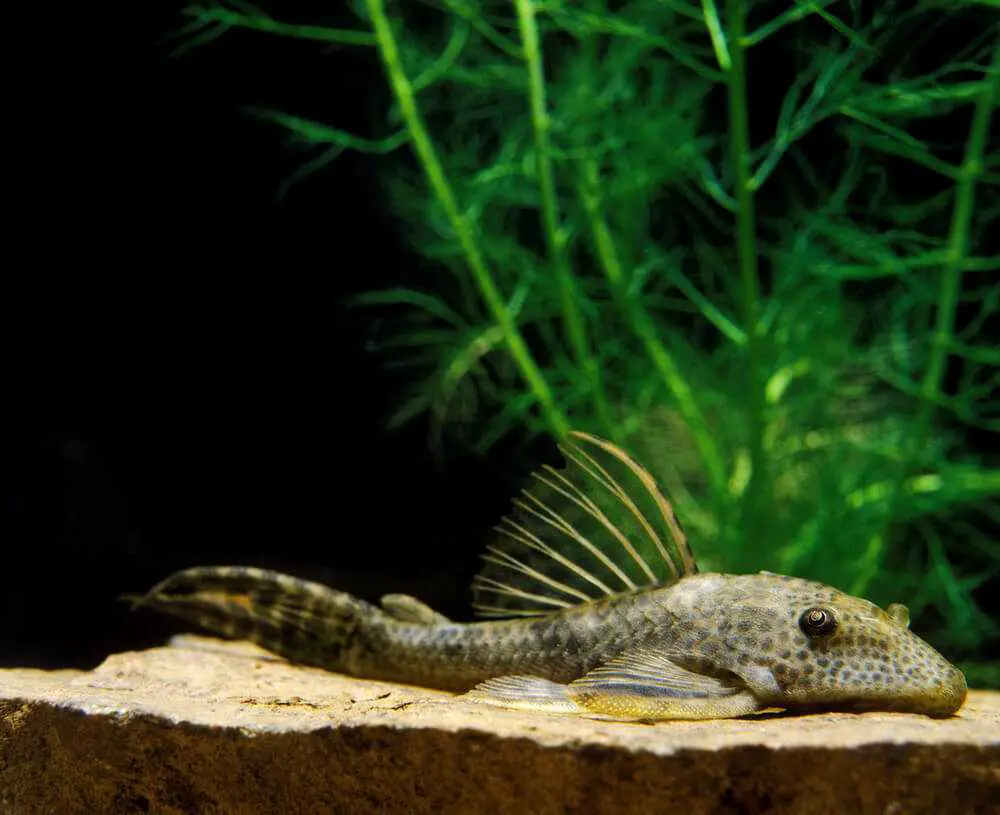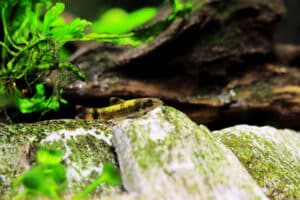Have you ever caught your pleco fish just chilling in the corner of the tank, and wondered if they’re catching some Z’s like we do?
Or maybe you’ve seen them being motionless in one spot and thought to yourself, “Hmm, are they sleeping or just being weird?”
Well, don’t worry, as fascinating as plecos are, they can be a little mysterious when it comes to their sleep patterns and habits. So, do Plecos sleep? Keep reading till the end to learn more.

1. Do Plecos Sleep?
The answer is yes, plecos do sleep. In fact, all fish need to sleep in order to maintain their biological cycle and function properly.
Like other animals, fish have a sleep cycle that is regulated by their internal clock, also known as the circadian rhythm. This internal clock helps to regulate the fish’s behavior, including when they sleep and when they are active.
During sleep, fish experience a reduction in activity and an increase in rest, just like humans do. This is important for the fish’s overall health and well-being, as it allows them to rest and recharge their bodies.
While sleeping the pleco fish may enter a state of quiet wakefulness during sleep, where they are still aware of their surroundings but are not as active.
Regardless of the exact mechanisms, it is clear that plecos, like all fish, need to sleep in order to maintain their biological cycle and overall health. So, if you have a pleco in your aquarium, it is completely normal to see them taking periods of rest and sleep.
2. How Often Do Plecos Sleep?
Plecos are creatures of the night! Well, at least when it comes to their sleeping habits. These cleaning friends are naturally nocturnal, which means they tend to be more active during the night and sleep during the day.
But don’t worry, that doesn’t mean they’ll be snoozing all day long. Although Plecos remain relatively inactive in some cases, when they are at their work, they do it pretty much tirelessly.
They’ll spend hours scouring the bottom of the tank for any stray bits of food or debris, using their powerful sucker mouths to vacuum up anything in their path.
So, even though they may be sleeping during the day, they’ll still be hard at work keeping their home spick and span. And if they need a little break, they’ll take a quick nap before getting back to their cleaning duties.
So, if you see your pleco snoozing away during the day, don’t worry – they’re just getting a little rest before they tackle their night shift!
Just make sure to provide them with a consistent light cycle and plenty of hiding spots in the tank to encourage their natural nocturnal behavior. With a little bit of effort, you can help your pleco thrive and keep your tank looking its best.
4. Is It OK If You Find The Pleco Sleeping Frequently?
If your pleco appears to be healthy (not exhibiting any symptoms of disease or stress) and the algae in the tank stays gone, the pleco is likely completing its job, particularly at night and there is nothing to worry. Aside from that, it’s not OK.
Unfortunately, plecos are not the energetic algae-eating fish in some cases. It is common for juveniles to vigorously clean the aquarium.
However, in certain circumstances, their activity levels decline slightly as they get older. As a result, they will be napping far more regularly than usual.
Whatever the reason, it’s not a good sign if your pleco spends too much time sleeping and hiding.
A healthy fish will be active, even if just a little bit. If your pleco seems unusually lethargic and uninterested in moving around in its tank, it may be an indication of illness, poor health or stress from improper tank conditions.
5. How To Know If Your Pleco Is Sleeping?
If you have a pleco in your aquarium, it is normal to see them taking periods of rest and sleep.
Here are a few common signs can help you know if your pleco is sleeping:
- Reduced movement: During sleep, plecos will experience a decrease in movement and activity. They may appear to be “floating” in one spot or resting on the bottom of the tank.
- Reduced response to stimuli: Plecos may not respond as quickly to stimuli during sleep, such as when you tap on the tank or offer them food.
- Relaxed body posture: Plecos may appear more relaxed and less tense during sleep, with their fins and gills not moving as much as usual.
It is important to note that not all plecos will show these signs of sleep, and some plecos may exhibit different behaviors when they are sleeping – which brings us to our next section!
6. Do Plecos Play Dead?
Although not very common, plecos can play dead – where they would remain upside down – as if they are in a deep sleep.
Playing dead, also known as tonic immobility, is a defense mechanism that some animals use to avoid predators. When an animal is in a state of tonic immobility, they appear to be motionless and unresponsive, as if they are dead.
Tonic immobility is thought to be a response to extreme fear or stress, and it can be triggered by physical restraint or by the presence of a perceived threat.
Some animals, such as certain species of sharks, can be induced into a state of tonic immobility by flipping them onto their backs.
Aquarium species like the cory catfish display the behavior of playing dead as a sign of stress from water conditions or improper health.
While an animal in a state of tonic immobility may appear to be unconscious, they are still aware of their surroundings and may be able to perceive stimuli.
Tonic immobility is a natural defense mechanism that can help animals avoid predators and other threats.
However, it is not a healthy or normal behavior for an animal to exhibit on a regular basis, and it can be a sign of stress or discomfort.
7. How To Make Your Pleco More Active?
Plecos are generally considered to be relatively inactive fish, and they are not known for their high levels of activity. They tend to spend much of their time resting or hiding in hiding spots in the aquarium, and they may not be as active as other types of fish.
However, it is important to note that plecos, like all fish, have different personalities and activity levels. Some Plecos may be more active than others, and their activity levels can be influenced by factors such as their age, size, and overall health.
If you would like to make your pleco more active, there are a few things you can try:
Create a suitable habitat: A happy pleco is an active pleco, so make sure your tank is set up with the proper conditions to keep them feeling their best. This includes the right temperature, pH, and filtration, as well as plenty of hiding spots and other features that promote natural behavior.
Encourage their nocturnal nature: Plecos are naturally more active at night, so try providing them with a consistent light cycle and plenty of hiding spots in the tank to encourage this behavior.
Don’t overcrowd: Overcrowding can cause stress and reduce activity levels in plecos, as well as other types of fish. Make sure your pleco has enough space to move around and explore.
With a little bit of effort, you can help your pleco become a more active and engaging member of your underwater community.
8. Is Your Pleco Sleeping Or Dying?
At first glance, sleeping and dying symptoms in Pleco can look too similar. But a closer inspection will help you differentiate between both conditions.
If your pleco is sleeping:
- They will typically be in a motionless or relaxed position, with their fins and gills not moving as much as usual.
However, if your pleco is dying:
- They may exhibit unusual or distressed behavior, such as rapid breathing, lethargy, or loss of appetite.
- They will lose their body color – turning white, or have spots on their body which is a symptom of Ich disease.
- They will display too much lethargic behavior than usual, and they may have difficulty swimming or maintaining their balance.
9. How Long Do Plecos Live?
Plecos have a longer life compared to popular fish species like a betta fish. Even in the worst case scenario, a pleco can live up to five years, and if the tank conditions are right, plecos can live up to 15 years.
Plecos are hardy fish and they can tolerate a wide range of water parameters. But in some cases, improper care or conditions can affect their lifespan and put them in stress.
It is important to provide plecos with a spacious and well-maintained tank, proper filtration, and a varied diet to ensure their longevity.
Plecos are large fish and require a tank of at least 20-30 gallons, with larger species needing even more space. It is also important to maintain proper water quality by performing regular water changes and using a high-quality filter.
In terms of diet, plecos are omnivorous and require a varied diet including both vegetables and protein.
They will graze on algae in the tank, but it is important to supplement their diet with vegetables such as lettuce, cucumber, and zucchini, as well as protein sources like frozen or live brine shrimp and bloodworms.
Overall, proper care and attention to the needs of your pleco can help ensure a long and healthy life for your fish.
Read Related: Can Plecos Eat Fry In The Fish Tank?
Wrapping Up
Plecos are some of the most unique and interesting fish around. Not only do they have a distinctive appearance, with their suckermouths, but they also have impressive sleep habits.
While they may seem like they are always lounging around, these fish do their job quite tirelessly whenever they are in their work mode. They will move around the tank, grazing on algae and munching on tasty treats.
But that said, when it is time to rest, they will not hesitate to find a cozy spot in the tank to sleep and drift off into fishy slumberland.
If you are a pleco owner, be sure to give your little buddy plenty of space to sleep and play. A well-rested and active pleco is a happy pleco!
Hi! I’m Praveen Ghoshal, the founder of eFishkeeping.com. Inspired by my Dad, I got interested in fishkeeping when I was a kid. Since then, I have been involved with this hobby. Currently, I have 3 fish tanks at our home, and I enjoy this hobby with my full family. Read more about me here.






![Do Neon Tetras Die Easily? [Here’s The Truth!] do-neon-tetras-die-easily](https://efishkeeping.com/wp-content/uploads/2023/03/do-neon-tetras-die-easily-300x200.jpg)

